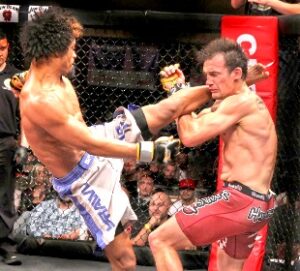
Are you wondering what Vale Tudo is?
In this article, we’ll examine what Vale Tudo is, Vale Tudo rules, Vale Tudo’s history, whether Vale Tudo still exists, Vale Tudo deaths, the most famous Vale Tudo fighters, and Vale Tudo vs MMA.
Contents
What Is Vale Tudo?
Vale Tudo is a full-contact combat sport with very few rules that started in Brazil in the 1920s. Vale Tudo is known as No Holds Barred (NHB) in America, and translated means ‘anything goes’ – reflecting Vale Tudo’s allowance of all techniques, especially those now illegal in modern MMA such as headbutts and eye gouges.
Vale Tudo is the precursor to MMA as fighters of different martial art styles would fight each other to see which style or combination of styles was most effective. As Vale Tudo was anything goes, Vale Tudo fighters would strike, wrestle, and use jiu-jitsu while standing and on the ground.
From the 1920s until Vale Tudo was phased out in the early 2000s due to the rapid development of MMA, most Vale Tudo fighters were Brazilian jiu-jitsu, Luta Livre, or catch wrestling style fighters. Because of this, Vale Tudo was takedown heavy and a lot of the action was on the ground.
What Are the Vale Tudo Rules?
As Vale Tudo means ‘anything goes’, fighters could use many techniques which are illegal in today’s MMA. This included headbutts, groin strikes, biting, fish hooking, eye gouges, and soccer kicking a downed opponent.
Essentially, the essence of Vale Tudo was to defend against all possible attacks and utilize any means necessary to secure victory. Vale Tudo fighters were competing as it was a life-and-death situation.
Vale Tudo fighters could wear a mouthguard and cup protection if they desired, but there were no rules stating they had to.
The original Vale Tudo rules were as follows:
- No Time Limit: there were no breaks and matches continued until a winner emerged
- No Gloves: fighters competed bare-handed (no wraps)
- No Weight Classes (Openweight): fighters of all sizes competed against one another
- Wins are only achieved via knockout or tapout: there were no decision victories
- All striking and grappling martial arts allowed
As MMA started to develop rules in the late 90s and early 2000s, Vale Tudo came under fire, and promotions were pressured into introducing rules – essentially turning Vale Tudo into MMA.
This included rules such as:
- Fingerless MMA Gloves: to protect fighters’ hands and reduce the risk of cuts
- Illegal Moves: groin strikes, eye gouging, and fish hooking were made illegal to make fights more technical and less barbaric
Vale Tudo History
Vale Tudo originated in Brazil in the 1920s when members of the Gracie family such as Carlos and Hélio Gracie began promoting fights showcasing their Brazilian Jiu-Jitsu style.
These matches were designed to prove the effectiveness of their martial art, which emphasized ground fighting and submission holds against other fighting styles. Vale Tudo caught on and became part of Brazilian culture, where it began forming part of the entertainment at circuses.
Vale Tudo remained this way until it was featured on a Rio TV show called Heróis do Ringue (“Heroes of the Ring”) in 1960. However, the show was soon canceled after a Brazilian jiu-jitsu practitioner known as João Alberto Barreto broke the arm of a Luta Livre fighter live on air.
Vale Tudo was considered too brutal for mainstream media, so it reverted back to its underground roots where fights took place in gyms and at the circus.
Vale Tudo came back into the spotlight in 1980 when the Maracanãzinho stadium in Rio de Janeiro sold out for a fight between Rickson Gracie and Casimiro de Nascimento Martins. In 1991, TV Globo, Brazil’s largest broadcaster, televised 3 Bjj vs luta livre fights under Vale Tudo rules.
This all led to the UFC’s founding in 1993, due to Rorion Gracie going to America and marketing the Vale Tudo style Gracie Challenge which had been taking place since 1920s Brazil. With the martial art vs martial art concept, Rorion Gracie along with a few other founders created the UFC.
The Vale Tudo influence on the first few UFC events was clear to see, as the events were labeled ‘No Holds Barred’ and marketed as having no rules, however, eye gouging and biting were illegal.
As the UFC and MMA developed with the creation and wide acceptance of the 2001 Official Unified Rules of MMA, Vale Tudo had given way to MMA, and Vale Tudo as it was supposed to be without rules was again sent underground.
Does Vale Tudo Still Exist?
Yes, Vale Tudo still exists in 2023. Most Vale Tudo fights occur in Brazil and are kept underground, as all Vale Tudo promotions eventually adopted the Unified Rules of MMA throughout the 2000s until Vale Tudo was no longer promoted live.
Rio Heroes and the International Vale Tudo Championship (IVC) were great Vale Tudo promotions in the early 2000s. Unfortunately, the IVC folded its Vale Tudo fights in 2003 as the State of São Paulo stopped allowing sanctioned Vale Tudo. In 2011, the IVC returned with the adoption of the Unified Rules of MMA.
It’s the same for other Vale Tudo promotions. They’re not actually promoting Vale Tudo as they’re using MMA rules. This includes the use of fingerless gloves to protect the fighter’s hands and banning techniques such as head butts, groin strikes, fish hooking, and eye gouging.
Originally, Vale Tudo was used as a synonym for MMA in Brazil, but as rules came into place and gave way to MMA, Vale Tudo became referred to as the old Vale Tudo used from the 1920s to the early 2000s.
Has There Been Any Vale Tudo Deaths?
There has never been a death as a result of a Vale Tudo, at least not recorded. However, it’s hard to say because the majority of Vale Tudo has been unsanctioned, underground fights, where deaths may have been covered if there were any.
And while there’s never been a Vale Tudo death, critics of Vale Tudo claim it to be dangerous and bloody, and that the adoption of the Unified Rules of MMA made the sport safer. For this reason, Vale Tudo started to be phased out in favor of MMA in the early 2000s.
In fact, Vale Tudo may be safer than MMA, much the same way MMA is safer than boxing because it uses smaller gloves. Larger gloves mean impact is reduced and fighters therefore take many more blows to the head which leads to brain trauma.
There are also many countries that haven’t adopted the Unified Rules of MMA, such as Japan, Singapore, Russia, and Thai promotions.
Who Are the Most Famous Vale Tudo Fighters?
The most famous Vale Tudo fighters of all time are:
1. Rickson Gracie
- Never lost in over 300 fights within Jiu-Jitsu and Vale Tudo
- Fought in the first and second Vale Tudo Japan tournaments
- His success helped inspire the creation of MMA
- Rickson was considered the most elite fighter of the Gracie family
2. Helio Gracie
- Co-creator of Brazilian Jiu-Jitsu
- Competed in approximately 20 different bouts over four decades (1932-1967)
- Fought against practitioners of various martial arts including judo, wrestling, capoeira, and boxing
3. Masahiko Kimura
- Considered by many in judo as the greatest Judoka of all time
- Known for his Vale Tudo match with BJJ creator Helio Gracie, where he broke Gracie’s arm using the gyaku ude-garami, a move now known as the Kimura in his honor
4. Carlson Gracie
- Considered the best fighter within the Gracie family during his prime
- Fought for three decades from the 1950s to the 1970s, losing only one fight
- Known for avenging his father by beating Waldemar Santana
5. Marco Ruas
- Started fighting within Luta Livre and Vale Tudo and went on to have a successful MMA career, including winning the UFC 7 tournament
- More than half of his fighting career took place under Vale Tudo rules bouts
- One of the first fighters to use leg kicks effectively in Vale Tudo fights
6. Euclydes Hatem
- Creator of the martial art Luta Livre
- Known as one of the greatest fighters of his era
- Defeated numerous opponents using chokes and armlocks, including George Gracie and Waldemar Santana
7. Rei Zulu
- Specialized in a Brazilian martial art called Tarraca and was also well-versed in wrestling
- Had around 200-300 Vale Tudo fights in his career, retiring in 2009 at the age of 62
8. Waldemar Santana
- A pioneer of MMA and a legend within Vale Tudo
- Practiced everything from Capoeira, Boxing, Jiu-Jitsu, and Luta Livre
- Fought the very best fighters in the world, including beating Helio Gracie
9. Wanderlei Silva
- Known as The Axe Murderer, Silva started as a Vale Tudo fighter (97-99) and transitioned to MMA to become one of the most popular and exciting fighters in the sport
Vale Tudo vs MMA
The main difference between Vale Tudo and MMA is the rules.
Vale Tudo matches had no rules, while the overwhelming majority of MMA promotions adopted the Unified Rules of MMA in 2001. These rules included 5-minute rounds, 27 fouls (ban on groin strikes, eye gouging, striking the back of the head), the use of MMA gloves, and the wearing of a cup.
The fighting is also different in Vale Tudo vs MMA because of these rules. As Rickson Gracie put it in his book, Choke, MMA is a game and Vale Tudo is a war. This is true because in MMA you can win 2 out of 3 rounds and get saved from a choke in the third and still win. Who really won that fight?
Also, the fighting is different because the time limits change the strategy used. In Vale Tudo, there is no 1-minute rest between rounds so fighters are always having to strategize like it’s a war, whereas MMA fighters can go as hard as possible in a round and slack in certain rounds to play the game of MMA.
The last difference is how Vale Tudo was takedown-heavy due to its origins in Luta Livre and catch wrestling, whereas MMA is now mostly striking-heavy due to everyone learning Brazilian jiu-jitsu and its effectiveness being lowered, and how many MMA fighters have great takedown defense and can keep fights on the feet.
Overall
Vale Tudo is a full-contact combat sport started in Brazil in the 1920s with very few rules restricting what fighters could do. The rules making Vale Tudo were that the fights had no time limits, fighters didn’t use gloves, and all fights were openweight.
Today, Vale Tudo exists only underground as regulated Vale Tudo is essentially MMA due to the rules governing the sport.




